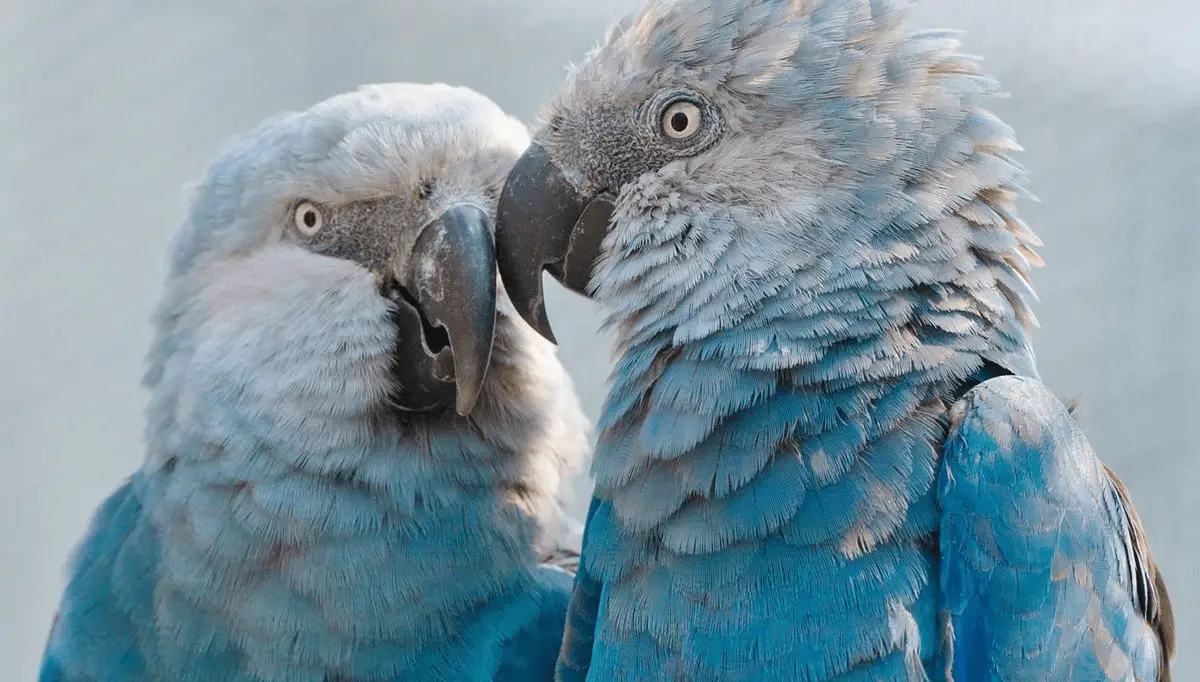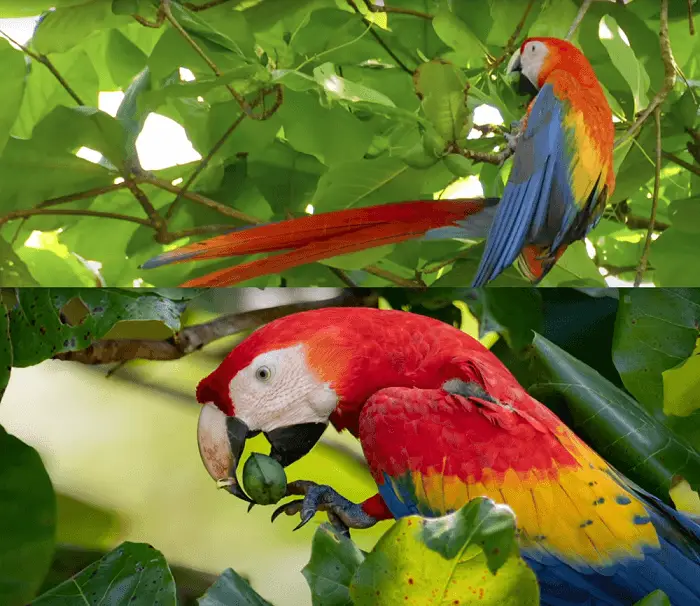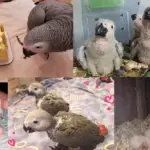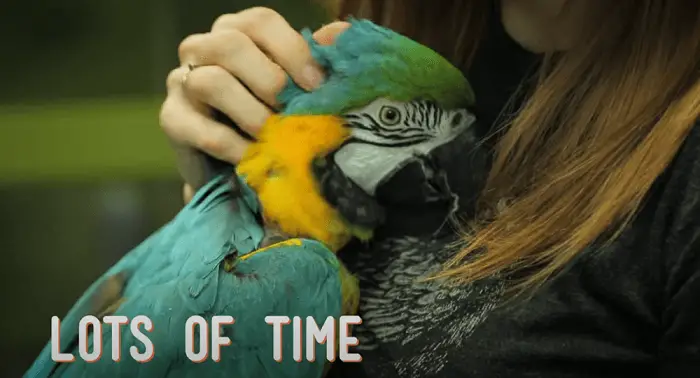
Macaws are very large parrots with long tails, long narrow wings, and brightly colored plumage. They all have a characteristic patch of bare skin around the eyes.
Males and females have similar plumages. Many of these species are very popular pets and for this reason, some of them have become quite rare in nature.
Have you lost your mind for his majesty Macaw Parrot? Unsurprisingly, these majestic birds are for many the embodiment of parrots.
It is easy for these animals to captivate people with their beauty and intelligence, their confidence, and their joie de vivre. Parrot lovers know, however, that: a lot of effort and empathy is required to raise a parrot in life conditions adapted to the species.
Class: poultry Family: Psittacidae
-
originCentral and South America
-
waist80 – 90 CM
-
weightup to 1.4 KG
-
aspectfacial mask (almost) without feathers, thin body, long tail, wide head, and strong beak
-
plumagegreen, red, or yellow feathers with wings and tails of different colors depending on the subspecies
-
Life expectancyit can be up to 40 years old on average, but there are examples of 90-year-old birds in the literature
-
characterintelligent, demanding, sensitive, jealous
Description
The wings and the tail of the yellow-blue macaw, like those of all the species of the genus macaw, are very long.
The species of the genus Ara are large parrots ranging in size from 46-51 cm and 285-287 g of the brown-fronted macaw to 90–95 cm and 1708 g of the red-green macaw.
Like all parrot species that have to travel great distances to find food, these macaws also have long, narrow wings. They have a large upper branch of the beak curved downwards and an area of hairless skin around the eyes that extends to the base of the beak.
In this bare area, there are tiny feathers arranged in lines of varying appearance from one species to another, except in the scarlet macaw, which has none.
In almost all species the beak is black, but that of the scarlet and red-green macaws has a horn-colored upper branch and a black lower one.
The colors of the plumage of the macaw species are spectacular. Four species are predominantly green, two are blue and yellow, and three (including the now extinct Cuban macaw) are almost all red.
In the plumage, there is no sexual dimorphism and also that of the immature is similar to that of the adults, although in some species it is a bit duller
Macaw Habitat
Macaws are native to the tropical forests of Central and South America where they migrate outside the breeding season in groups of ten to twenty animals.
Their search for food stretches for several kilometers. The habitat of Macaws parrots is shrinking, particularly due to overexploitation and residential areas.
The macaws combine to form couples throughout life and show a very differentiated social behavior within the group. Having a Macaw bird as a pet means:
That it must have a partner, otherwise behavioral disorders such as dreaded plucking of feathers or attachments to harmful humans will inevitably occur. But a human can never replace a congener Macaw, even in part.

Species of the macaw parrot genus live in the neotropical region and are widespread from Mexico to Argentina. The largest number of species live in the Amazon River Basin and in the region on the border between Panama and Colombia; in both areas, four species live together (or even five, in some areas on the margins of the western Amazon where the military macaw bird is pushed).
Seven species live in Bolivia, but nowhere in the country (as in any other area) do more than four species coexist. The species with the widest range, the scarlet macaw, is (or rather was) widespread in almost all of Central America and the Amazon.
The other way around, Macaw Golablu and the Fronterossa Macaw parrot only live in a few areas of Bolivia. The range of many species has decreased significantly in recent centuries due to human intervention.
The military macaw is widespread from northern Mexico to northern Argentina, but has a discontinuous diffusion: one population is found in Mexico, a second, many kilometers away, inhabits the Venezuelan Coast Cordillera and a third is widespread along the Andes. , from western Venezuela to northern Argentina.
The yellow and blue macaw disappeared from Trinidad in the 1960s and it has become very rare in northern Argentina; other species appear to have disappeared from some Caribbean islands as well.
The species of the genus macaw bird adapt very well to all the environments of the area where they live; as you can easily guess, given its vast range,
the most adaptable species is the scarlet macaw, which lives in a vast range of habitats, from humid rainforests to open scrubs and savannas. The only requirement it needs is the availability of large trees where it can find food and cavities in which to nest.
The other species are a bit more demanding, but they too need large trees. The blue-eyed macaw generally lives in forest “islands” surrounded by savannah and the red-headed macaw prefers arid scrubs and cactus groves.
Within their range, these birds make seasonal migrations in search of food. However, they do not migrate on a large scale, but rather small local movements from one habitat to another.
Macaw Living Conditions
A bird as big as macaws needs above all one thing indoors: Lying. This means that you must offer your pets an aviary or a bird room. Accommodation should only be used for unavoidable temporary security or as a dormitory.
It must be very large: The outstretched wings of the bird must not touch any sides. The average size of macaw parrots is 90 centimeters with a wingspan of about 90 to 115 centimeters.
Many macaws develop intimate relationships with their owners because many of them interact freely. Having changing materials for occupancy and toys is important for the balance of birds.

Macaws Species
There are subspecies in the macaw bird family that are distinguished by their color.
- Red macaw: red base plumage, large blue feathers, and rectrices, yellow spot on the wing, light beak
- The Blue macaw: yellow feathers on the chest and lower wings, blue upper body, dark beak, black throat
- macaw chloroprene or green-winged macaw: red base plumage, large blue feathers, and rectrices, green air blankets, clear beak
All macaws have the possibly sparse feathered face mask with an individual stripe pattern on a common white background.
Macaw Diet
The mace finds a rich variety of buds, fruits, and nuts in the lush vegetation of its natural habitat so that the bird’s menu in domestic environments is frugal and is complemented by adapted parrot food mixes.
The bird is perfectly able to crack the seeds and grind the fruit with its large and strong beak using its claws as a gripping tool.
Give the macaws fresh twigs and nibble wood to keep their beaks busy. However, you should not give them peanuts in shells: There is a risk that mold spores will enter the parrot’s lungs.

Reproduction
Like almost all parrots, macaw species nest in cavities. Most species make their nests in the hollows of trees, both alive and dry.
They use both natural cavities, mainly present in dry trees, and those created by other species; in Mexico, the military areas still use the cavities dug by the imperial woodpecker, now very rare.
In addition to the trees, the military macaws and the red-green macaws also nest in the natural crevices of the escarpments.
The fronterossa macaw nests only in the latter, given that in the arid habitat in which it lives there are no sufficiently large trees.

Macaws as pets
Macaws are intelligent and curious animals with a natural ability to imitate voices and sounds. They tame each other very well, let themselves be caressed, and learn little tricks if you direct their mood in the right direction.
The installation may suffer from the great strength of the bird’s beak. Careful basic training for macaws that are part of a human home is therefore absolutely necessary: these intelligent animals quickly learn what is desired and forbidden.





















